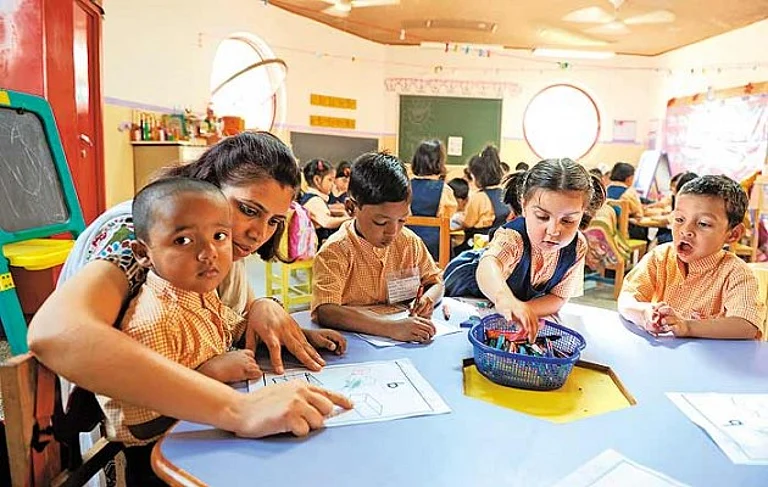It was past seven in the evening. The light was leaving the hills. In front of my hotel balcony, the scarlet of rhododendron blooms was being obscured by a fluid, purposeful fog. Lights pricked out vaguely along the road, dogs barked incessantly, a stiffish breeze jangled wind chimes somewhere. The streets began to look ghostly: the residents of Pelling had left them to their devices and retired for the night. It was, to my nostalgic mind, a scene out of a Dev Anand movie from the ’60s — any minute now, the dapper hero would emerge from the haze as he did once on the streets of mist-enveloped Shimla and pace the pavements crooning “Tu kahaan, ye bataa”, searching the casements for his beloved. That was Pelling.
From spectacular mountains to tranquil monasteries, the tiny state of Sikkim throws out many lures to the traveller. We were going to do the classic, thoroughly touristy, circuit sweetened by a few charming farm and village stays: we first swooped on West Sikkim, meandered there in random loops before making a straight line east to Rumtek, and ending further east at Sikkim’s border with China at Nathula. Poring over the map, we seemed to have cut a swathe through the middle of the small state, avoiding the extreme north as well as the busy south. It was a good run.
Two days before, Saibal Das and I had endured our first introduction to Sikkim’s roads — journeying from Bagdogra to the small town of Rinchenpong . So execrable were some stretches, I pondered in desperation—as we rocked and flew off our seats — the plausibility of touting the state as an off-road adventure. But worth it all, for we halted at Yangsum Farm, the prettiest farm imaginable. They had a warm dinner ready for us: a soup of slightly fermented radish, rice, rotis, beans, potatoes, cabbage. Every vegetable picked on the farm itself. Just a few hours ago, the plains had baked us gently but the hills were deliciously cool. I donned my precious toe-socks and took a hot-water bottle to bed. In the morning, across several layers of hill, the mighty Kanchenjunga glistened. It was an auspicious beginning.
The 44-acre Yangsum Heritage Farm was much what you’d like a farmhouse to be. Family run, with a couple of rambunctious dogs haring after each other, a kitten snuggled up to yet another. I was pointed to various trees (winter pear, mango, guava, orange); to various plots of vegetable (spinach, fat cabbages resting among leaves, turmeric)… Farmville is no patch on it. We walked around the pleasant property, past a small collection of chortens protected by the ubiquitous rhododendron, past scampering orange-bellied Himalayan squirrels, past noisy sunbirds.
Thendup Tashi’s people have lived here for generations and the homestay is clearly a labour of love. What used to be storage has been converted into rooms and even the newly added sections are built in the traditional style. After a lunch of gyathuk (noodle broth) and churpi (dried yak cheese), we braved the road and pulled up three hours later at a Help Tourism guesthouse in Upper Hee. This accommodation, also within sight of the Kanchenjunga, is acceptably picturesque and located on the lip of a smallish lake called Chayatal. The Hee Bermiok region happens to be a Limboo stronghold and I heard that evening the story of the great Limboo leader Srijunga. This was the man who developed a script for the Limboo language and was, by all accounts, an inspirational chieftain. He grew to be influential enough to challenge the Bhot ruler of the time — and suffered (and warded off) several murderous attacks. Srijunga’s Bhot wife was tortured into revealing her husband’s Achilles-style weakness and he was finally killed with a blow to the stomach. A rivalry of sorts still thrives between the Bhots and the Limboos. Saran, the man in charge of the Hee guest house, pointed to me with some satisfaction Gufa Dara, the hill that will bear a 108ft statue of Srijunga. This gives the Limboo people their beloved ruler to look up to but comes with the side benefit of being visible for miles — a sight quite certain to torment the predominantly Bhot-inhabited regions on the other side, who still consider him the enemy.
Morning tea in Hee was a pleasure. A little tray with jam-centred biscuits and a red, aromatic brew of Assam CTC. I’m promiscuous when it comes to tea, liking it in all its avatars — delicate Darjeelings to English Breakfast, supermarket staples to Irani chai. Still, elaichi somehow eludes that catch-all net: I’ve always thought the flavour sickly. But I hadn’t tasted the bite that badi elaichi or greater cardamom confers on tea, or the subtle way they serve it here. Two cups to cleanse the palate — and make you keen for the rest of the morning.
We removed to Pelling the next day and went off directly to pay our respects to one of the oldest monasteries in Sikkim, the magnificent Pemayangtse monastery. We had barely set foot on the first step when the weather turned atmospheric. The wind picked up pace, prayer flags worked furiously and the sky swooped down on us. Inside, a few monks sat in prayer, lamps flickered fervently and a smiling young monastic student led me upstairs to the wonderful seven-tier wooden depiction of Guru Rimpoche’s ‘Heavenly Palace’.
Pelling-of-many-moods cleared up the fog the next morning as we took in the Rabdentse ruins, the site of Sikkim’s second capital that was occupied in the 17th century. The ruins disconcerted me somewhat. Imagine these buildings crumbling quite naturally in a time-lapse motion over the years to suddenly be stilled…frozen in stasis. There are neat paths and stairs leading here and there; low parapets skirt the area. Walls are being scrubbed and treated by restorers — so well looked after, the word ‘ruins’ seemed out of place. The Archaeological Survey of India has, no doubt, done its job in showcasing a historic site, but perhaps so heartily as to rid it of its erstwhile resident spirits.
We moved next to Tashiding. This is an utterly charming village: a market with a boggling variety of merchandise thrives all along the main road, happy teenagers mill about a computer centre that doubles up as internet café. I could not resist checking my mail and found two youngsters hunched over monitors, engaged in demolishing aliens. Tashiding, like most of the state, goes to sleep early, soon after nightfall. But in the evening, bevies of chattering girls stroll the main street, toddlers in tow, for their dusk constitutional. Children run after each other, extracting maximum fun from the day before it is done.
Tashiding has two monasteries in its environs and we visited the farther one — the Sinon monastery — first. Not very much on the tourist circuit, this was a calm temple. The sun beamed gently, puffs of cloud hovered overhead and the doors were opened to us on request. Upstairs, rows of small pigeonholes, each occupied by a manuscript sandwiched by wooden slats and wrapped reverently in cloth. These shelves contain, perhaps, esoteric secrets of life and death, of existence and non-existence.
We met a well-dressed man here who walked us around. A teacher, he told us, waving a hand at the school nearby. The school was a modest one but I was a little stunned to learn it taught only 15 students. But so it is. People in Sikkim place a premium on education and learning. Everywhere we drove, we came across bunches of smartly uniformed children and young people walking to school. Some walk as many as 10km every day, eating only two meals—a solid breakfast and coming back home to an early dinner. Shortcut trails up and down the hills might lighten the walk but, in the rains, landslides and detours add spice to a daily adventure.
Tashiding’s other monastery is a far more elaborate affair. There are several buildings apart from the central prayer hall but the most remarkable sight of all is a clutch of chortens, some aligned, some higgledy-piggledy but breathtaking together. These are considered highly sacred — merely the sight of these reliquaries is supposed to cleanse all sins. That was lucky, then — we must try all the means at our disposal.
In contrast, I felt far less moved by the Rumtek monastery that we visited next. Much celebrated, very beautiful, more accessible but also overrun by officious security guards. But here also, like in all the others: ornate seats, high backs painted in the bold kitsch so favoured by Himalayan monasteries; behind glass, a series of gurus, incarnations, histories, fables.
We dropped anchor at Teen Taley for two nights. A farm again, with private cottages, nice views and an abundance of trees and flowers. Mrs Sharma, the owner, invited us uphill to look over the homestead: cows, sheep, a puja room and a guard dog. We stepped into her kitchen for a cup of tea and I was entranced by her mud stove, lit with firewood, where she expertly tossed a large quantity of julienned potatoes and seasoned them — dinner for the family and the stay-behind staff. That is the idea behind the resort — a village experience, a call to go ‘back to the roots’. A reminder of the simple things, the more important things.
Rumtek draws people for the temple but also provides a superb view of Gangtok, some 24km away. From my room that night, I parted the curtains to look upon Sikkim’s capital across the valley, glittering with a million lights. I’m told that on a good day — one that brings together clear skies, recent snow and a fullish moon — you can see the white peaks from here. What a picture that must make! Miles of earth, full-muscled lofty mountains, brave hill-city — all in one frame.
We wound up our Sikkim crawl with a cherry on top. The high pass of Nathula is the state’s border with China’s Tibet and a favourite with tourists. Higher and higher we went, in what seemed an interminable climb. We stopped to hire galoshes and then smatterings of snowfall appeared, then gorgeous high-altitude lakes, half-frozen still; then snow, snow and nothing but snow. Snow pigeons swooped about in formation and, in the distance, lammergeiers hunted. The motorable road of Nathula is also a trading post with China. Not a new one by any means: it was one of the stops on the fabled Old Silk Route. The ‘pass of whispering ears’ has probably heard the prattle of merchants who went this way centuries ago, heard the squeak of wagon wheels, the whinnies of mules as it now hears the blare of tourist taxis.
We passed Sherathang, a marketplace six kilometres from the border, where the goods from Tibet come to be traded between June and September. Finally at 4,310m, the barbed wire. A red-and-gold building on the other side proclaimed Chinese identity. Tourists took pictures and everyone shivered and dug their hands into their pockets.
On our way back we stopped at the picturesque Tsongmo lake. Yaks and herdsmen, all made up beautifully, standing by to waylay tourists. I obligingly hopped on to a yak, smiled for pictures and recorded for myself what the yak gait feels like — wobbly but safe.
We stopped at Gangtok for two brief hours — but two hours can be enough, I found, to be charmed. M.G. Marg is a beautiful promenade market. Cars are not allowed and, any shopper will tell you, it makes for easier hunting-and-gathering. By order, the buildings here may be painted green only and there was among the shopkeepers, I felt, a struggle to express themselves creatively. Still they managed, for I counted a dozen shades of the colour. But there was no need: the riotous flowers all along the centre, the fountains and the benches beautify the market more than sufficiently. I longed for such a pedestrian-only market in my own city and engaged for a futile hour in mentally removing arterial streets and wiping out a quarter of our cars to fit it in.
We were done. The next morning, we set out for Bagdogra again. The river Teesta joined us halfway and escorted us companionably down the hills all the way to Sevoke before she went her way and we went ours.
Sacred hills
The calm of Sikkim’s hills carries a divine retreat-like aura about it — but clearly we're not the pioneers who discovered this. That these benign, beautiful heights are conducive to meditation is old knowledge, borne out by the near-200 monasteries dotting Sikkim's remote, inaccessible hilltops. These gompas, mostly belonging to the Nyigma and Kagyu orders of Buddhism, are an integral part of Sikkim’s spiritual heritage. Lamas robed in red and yellow, the rhythm of ceremonial drums and trumpets, the creak of prayer wheels, the ornate statues of the Guru Padmasambhava, flickering lamps, fluttering flags — these are the sights and sounds of Sikkim’s cultural landscape. Ancient rituals are practised here, and the festivals and enduring faith fascinate.
Apart from the more-visited Rumtek, Pemayangtse and Tashiding, there are several gompas worth a visit: the Karma Kagyu monastery in Phodong with its fabulous murals; the 200-year-old Enchey monastery in Gangtok; the old Sanga-Choeling monastery off Pelling, accessed only through a one-and-a-half hour trudge through thick forest. Monasteries usually open around 7am and close at 4pm. If you find one closed, do ask if it can be opened for you.
High adventure
Sikkim is an absolute trekker’s delight. There are trails of varying difficulty and various altitudes: in the lower hills of West Sikkim, there are several routes between Pelling, Yuksom, Tashiding and Legship. The Dzongri-Goecha la trek is extremely popular as well, for it offers fabulous views of the Kanchenjunga. In the more rugged and unpopulated North Sikkim district, trekkers tend to include the Green Lake, the base camp for mountaineering expeditions to the high peaks. But treks into the more offbeat Yumthang Valley via Lachung are possible as well.
Jeep safaris are also a wonderful way to see the state’s beautiful landscape: the high-altitude, sacred lake of Gurudongmar (5,150m) is an absolute must-see. Permits entry into North Sikkim requires a special permit that takes a day to come through, and trekking to Green Lake in particular needs an additional trekking permit that can take up to two weeks to process. All permits need to be applied for through an authorised travel agent, and all forays conducted through them as well.
Birds, bees, etc
Over 450 species of birds, over 400 species of butterflies and moths, over 450 varieties of orchid, 40 species of rhododendron alone and around 140 mammals — all this in an area of 7,096 sq km. There is a reason for Sikkim’s truly astounding variety of life: its range of elevations. The lowlands begin from a modest 280m, but the mountain peaks tower at 8,585m and, in between, lies an ecological hotspot of great significance. The snow leopard is found here, as is the red panda and the blue sheep. Lammergeiers hover in the mountains; the amazingly coloured blood pheasant is seen here, as well as the snow cock and the satyr tragopan. The state tree, rhododendron, thrives in a riot of colour in March and April. Orchids have what you might call a field day.
The Kyongnosla Alpine Sanctuary (on the way to Nathula) harbours a wide range of flora and fauna. There are two sanctuaries — Barsey and Shingba — devoted to rhododendrons alone. Besides, the Deorali Orchid Sanctuary in Gangtok showcases some 200 species of the wild flower. Help Tourism conducts customisable birding and wildlife tours in Sikkim.





















